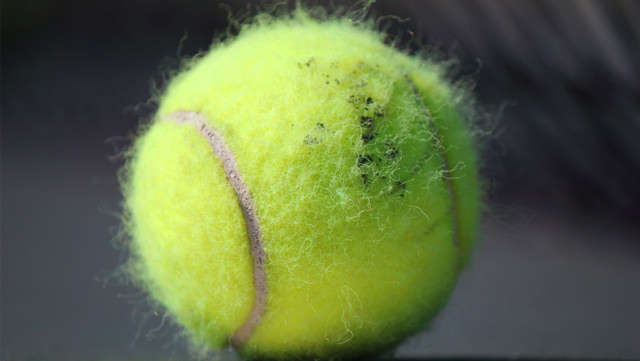You might know how to hit a perfect inside-out, down-the-line forehand, but we bet you don’t know everything about tennis. MyTennisLessons answers why tennis balls are fuzzy and other questions you have about the game.
Why are tennis balls yellow and fuzzy?
Today when you watch pro tennis on TV, your HD screen allows you to see every bead of sweat dripping from the players’ foreheads. Such was not the case in the 1970s when color television was a recently developed technology. Thus in 1972, the yellow tennis ball was introduced so that TV audiences could see the movement of the ball more easily. (Though unsurprisingly, oldfangled Wimbledon stuck to using white tennis balls until 1986.) Today, yellow tennis balls are still commonplace, though you can purchase leopard print ones if you so desire.
We’ve covered color, but what’s with the fuzzy texture? In the 16th century, during the nascent stages of tennis, balls were made from cork and covered with cloth, wool or hair, according to Tulsa University physics professor Jerry McCoy. As the result of tradition, tennis balls have maintained that fuzzy texture up through today, he says. But you didn’t think a physics professor’s answer would end there did you? The fuzz is all about performance. A tennis ball’s texture helps decrease speed and also allows players more control. Additionally, it helps supplement the effect of spin. But ultimately, McCoy says, a tennis ball is fuzzy because “that’s the way they’ve always done it.”
Why do tennis players wear white?
Theories as to why wearing white became popular among tennis players mostly point to social class. At the turn of the 20th century in America, white clothing became a status symbol for the upper class who could afford to spend their summers outdoors pursuing leisurely activities — these of course included tennis. As Emily Chertoff suggests in a 2012 Atlantic article, “Since white clothing dirties easily, it didn’t recommend itself to factory workers and domestic servants in a dry-cleaning-less era of weekly baths.” But white also had it’s practical purposes for the elite. A 2014 New York Times article states that the color prevented “the appearance of unseemly sweat stains as the sport became increasingly popular at social gatherings.” Today, white outfits are still mandated at some tennis clubs and most notably, for players at Wimbledon.
Why do tennis players live in Monte Carlo?
Victoria Azarenka, Novak Djokovic, Caroline Wozniacki and Marin Cilic and are among the many top professional tennis players who make their home in Monte-Carlo, Monaco, and they don’t just live there for the famous casino. In addition to being a tourist destination, Monaco is known as a tax haven — the tiny nation has a 0 percent income tax. It also doesn’t hurt that Monaco’s famous racket-wielding residents have free access to the Monte Carlo Country Club, a 23-court facility with a pool and fitness amenities in nearby Roquebrune-Cap-Martin, France. Why then doesn’t the WTA’s No. 1 player, Serena Williams, live in Monaco? Doing so would require her to renounce her U.S. citizenship, as would be the case with any other U.S. national. And what about up-and-coming pro tennis players? Why don’t they all call Monaco home? Because the country is “more suitable to those players who earn more than $1 million a year on the tour and pull in more money with endorsements,” according to an ESPN.com article by Darren Rovell. The same article notes that in order to establish residency tennis players must spend a significant amount of time in Monte Carlo instead of returning to their native countries. Hey — doesn’t sound like a problem to us.



